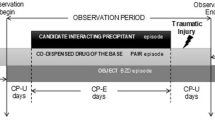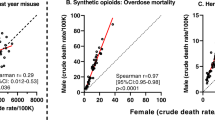Abstract
Background
National guidelines recommend screening all trauma patients for drug and alcohol use beginning at age 12, but no national data have examined rates of screening or positive results in this population.
Methods
We examined national testing rates and results among all trauma patients under 21 years old in the 2017 American College of Surgeons Trauma Quality Programs (TQP) database.
Results
Of a cohort of n = 157,450 pediatric and adolescent trauma patients, n = 45,443 (28.9%) were screened, and n = 16,662 (36.7%) of those had a positive result. While both testing and positive results increased with age, testing rates were only 61.7% by age 20 and the prevalence of positive results was significant even at younger ages. Cannabinoids were the most commonly detected substance, followed by alcohol, and then opioids.
Conclusions
These national data support the need for further efforts to increase screening rates and provide structured interventions to mitigate the consequences of substance abuse.
Impact
-
These data provide the first national evidence of underutilization of drug and alcohol screening in pediatric and adolescent trauma patients, with substantial rates of positive screens among those tested.
-
Cannabinoids were the most commonly detected substance, followed by alcohol and then opioids.
-
These data should guide physicians’ and policymakers’ efforts to improve screening in this high-risk population, which will amplify the potential benefits of using the trauma admission as a critical opportunity to intervene with structured programs to mitigate the consequences of substance abuse.
Similar content being viewed by others
Introduction
Traumatic injury remains the primary cause of pediatric mortality.1 National epidemiologic data demonstrate a substantial prevalence of drug2 and alcohol3 abuse among adolescents, which is a strong risk factor for injury.4 Single-institution studies have found high rates of positive screens for drugs and alcohol in pediatric trauma patients.5,6,7,8,9 But despite national guidelines for universal screening of trauma patients beginning at age 12,10 multiple small studies demonstrate low and inconsistent screening rates.11,12
These studies suggest that clinicians rely on clinical suspicion of intoxication as a criterion to test rather than adhering to a standard protocol.13 Underutilization of screening has implications both because it results in missed clinical insights for the immediate care of these patients and because it precludes an opportunity to identify patients who may benefit from structured interventions to mitigate the consequences of substance abuse, including trauma recidivism.14
No national analyses have assessed whether the findings of smaller studies apply more broadly. We sought to analyze patterns of screening and of positive screen results in a national cohort of pediatric and adolescent trauma patients. This information may guide clinicians’ sense of pretest probability and inform injury prevention and risk reduction strategies in the trauma population.15,16
Methods
We used the 2017 American College of Surgeons Trauma Quality Programs (TQP) Participant Use File (TQP PUF 2017, https://www.facs.org/quality-programs/trauma/tqp/center-programs/ntdb/datasets) a national database of 752 participating trauma centers’ registry data that conform to the National Trauma Data Standard. The content reproduced from the TQP PUF remains the full and exclusive copyrighted property of the American College of Surgeons, which is not responsible for any claims arising from works based on the original data, text, tables, or figures. This study was exempt from Institutional Review Board review because it uses deidentified data.
Out of a total database of n = 1,040,440 admissions, we excluded records with missing age information (n = 60,952, 6.1%) and identified a cohort of all patients under 21 years of age. We then identified patients who had drug and/or alcohol screens performed in their trauma admission. Alcohol screens were considered positive if the blood alcohol level was greater than 0.0 g/dL. Ecstasy, phencyclidine, and barbiturates were grouped as “Other” for the purposes of analysis. All analyses were performed using SAS (v9.4; SAS Institute, Cary, NC).
Results
We identified a cohort of n = 157,450 trauma admissions in patients under 21 years of age. Male patients (n = 105,053) comprised 66.7% of this cohort. The demographic distribution was similar to that of the American population: 61% white non-Hispanic, 19.3% Black, 18.6% Hispanic, 2.0% Asian, 1.1% Native-American. A total of n = 127,215 (83.1%) patients were admitted, n = 24,503 (16.0%) were discharged directly from the emergency department, and n = 1369 (0.9%) died.
Of the total cohort, n = 45,443 (28.9%) were screened for drugs and/or alcohol. The proportion of patients tested by age is shown in Fig. 1.
Of those screened, the proportion testing positive for at least one drug or alcohol was n = 16,662 (36.7%). The proportion of patients with positive screens by age is shown in Fig. 2.
Positive screens included the following distribution of drugs: cannabinoids in n = 9153 (20.1%), alcohol in n = 6418 (14.1%), opioids in n = 2128 (4.6%), amphetamines in n = 1800 (4.0%), cocaine in n = 1646 (3.6%), and other drugs in n = 580 (1.3%).
Discussion
These national data provide corroboration of the substantial prevalence of drug and alcohol use among pediatric and adolescent trauma patients. Not surprisingly, prevalence of positive screens increases most dramatically beginning at age 15, but the prevalence in the younger adolescent age range (11–14 years) remains significant. Despite national guidelines that recommend testing every trauma patient 12 years or older, testing remains the exception rather than the rule in this age range. Even 18–21-year-olds are far from a universal testing strategy, with more than one in three patients untested at age 20.
The overall magnitude of positive screening (more than one out of three patients) is generally consistent with smaller, single-institution studies that have used more focused screening (e.g. interviews or a combination of biochemical and interview screening), allaying concerns that the biochemical screening captured in TQP might significantly underestimate prevalence.10
Cannabinoids were the most common substance detected on screening, at over one in five patients, and nearly one in four patients age 11–20. This finding is noteworthy given recent efforts to decriminalize and legalize marijuana in many states, where prior work has suggested an association with increasing prevalence of marijuana-positive screens in trauma patients.17
Small but nonzero rates of positive screens in the youngest patients (under age 10) may represent very early experimentation with drugs and alcohol, but alternative explanations include environmental exposures (e.g. parental substance use), accidental ingestions, or medications administered in the prehospital phase of care. Prior studies have suggested an increasing incidence of accidental exposures of children ages 0–10 years in states with marijuana legalization, largely related to marijuana-infused edible products.18,19
This study has limitations inherent in the analysis of a national database: classification error, limited granularity, and a small amount of missing data—though these issues are less of a concern with the high quality of the registry-based data that comprise TQP. However, even with these limitations, we believe these data provide valuable information that should guide trauma systems in reconsidering universal screening protocols for pediatric and adolescent patients.
Biochemical screens should be obtained routinely as part of the initial trauma laboratory panel. These screens can be combined with verbal or computerized questionnaire screens to optimize total screening yield. Results should trigger social work interventions and outpatient pathways that address early substance abuse.
Conclusions
This national analysis demonstrates low utilization of drug and alcohol screening of pediatric and adolescent trauma patients, with substantial positivity among those tested. Cannabinoids were the most commonly detected substance, followed by alcohol and then opioids. The prevalence of positive screens increases with age but is significant even at young ages.
Efforts are needed to improve national screening rates, which will amplify the potential benefits of using the trauma admission as a critical opportunity to intervene with structured programs to mitigate the consequences of substance abuse, including trauma recidivism.
References
Shook, J. E. et al. Management of pediatric trauma. Pediatrics 138, e20161569 (2016).
Grant, B. F. & Dawson, D. A. Age of onset of drug use and its association with DSM-IV drug abuse and dependence: results from the national longitudinal alcohol epidemiologic survey. J. Subst. Abuse 10, 163–173 (1998).
Grant, B. F. & Dawson, D. A. Age at onset of alcohol use and its association with DSM-IV alcohol abuse and dependence: results from the national longitudinal alcohol epidemiologic survey. J. Subst. Abuse 9, 103–110 (1997).
Rehm, J. et al. The relationship between different dimensions of alcohol use and the burden of disease—an update. Addiction 112, 968–1001 (2017).
Loiselle, J. M., Baker, M. D., Templeton, J. M., Schwartz, G. & Drott, H. Substance abuse in adolescent trauma. Ann. Emerg. Med. 22, 1530–1534 (1993).
Maung, A. A., Becher, R. D., Schuster, K. M. & Davis, K. A. When should screening of pediatric trauma patients for adult behaviors start? Trauma Surg. Acute Care Open 3, e000181 (2018).
Nicolson, N. G., Lank, P. M. & Crandall, M. L. Emergency department alcohol and drug screening for Illinois pediatric trauma patients, 1999 to 2009. Am. J. Surg. 208, 531–535 (2014).
Mello, M. J. et al. Alcohol and other drug use in a sample of admitted adolescent trauma patients. J. Subst. Abus. Alcohol 6, 1077 (2018).
Noffsinger, D. L. et al. Alcohol and drug screening of adolescent trauma alert patients at a level 1 pediatric trauma center. Am. J. Emerg. Med. 37, 1672–1676 (2019).
Kelleher, D. C., Renaud, E. J., Ehrlich, P. F. & Burd, R. S., Pediatric Trauma Society Guidelines Committee. Guidelines for alcohol screening in adolescent trauma patients: a report from the Pediatric Trauma Society Guidelines Committee. J. Trauma Acute Care Surg. 74, 671–682 (2013).
Martin, K. L., Vogt, K. N., Girotti, M. J., Stewart, T. C. & Parry, N. G. Drug use and screening in pediatric trauma. Ther. Drug Monit. 33, 439–442 (2011).
Robinson, T., Tarzi, C., Zhou, X. G. & Bailey, K. Screening for alcohol and substance use in pediatric trauma patients: a retrospective review. J. Pediatr. Surg. 55, 921–925 (2020).
Rootman, D. B., Mustard, R., Kalia, V. & Ahmed, N. Perceptions and realities of testing for alcohol and other drugs in trauma patients. J. Trauma 63, 1370–1373 (2007).
Nunn, J., Erdogan, M. & Green, R. S. The prevalence of alcohol-related trauma recidivism: a systematic review. Injury 47, 551–558 (2016).
Gentilello, L. M. et al. Alcohol interventions in a trauma center as a means of reducing the risk of injury recurrence. Ann. Surg. 230, 473–483 (1999).
Cunningham, R. M. et al. Alcohol interventions among underage drinkers in the ED: a randomized controlled trial. Pediatrics 136, e783–e793 (2015).
Grigorian, A. et al. Marijuana use and outcomes in adult and pediatric trauma patients after legalization in California. Am. J. Surg. 218, 1189–1194 (2019).
Wang, G. S. et al. Unintentional pediatric exposures to marijuana in Colorado, 2009-2015. JAMA Pediatr. 170, e160971 (2016).
Wang, G. S. et al. Association of unintentional pediatric exposures with decriminalization of marijuana in the United States. Ann. Emerg. Med. 63, 684–689 (2014).
Author information
Authors and Affiliations
Contributions
Substantial contributions to conception and design, acquisition of data, or analysis and interpretation of data; drafting the article or revising it critically for important intellectual content; and final approval of the version to be published: all authors.
Corresponding author
Ethics declarations
Competing interests
The authors declare no competing interests.
Additional information
Publisher’s note Springer Nature remains neutral with regard to jurisdictional claims in published maps and institutional affiliations.
Rights and permissions
About this article
Cite this article
Maxwell, B.G., Lin, S., Greene, N.H. et al. Kids grow up so fast: national patterns of positive drug/alcohol screens among pediatric trauma patients. Pediatr Res 89, 767–769 (2021). https://doi.org/10.1038/s41390-020-01163-1
Received:
Revised:
Accepted:
Published:
Issue Date:
DOI: https://doi.org/10.1038/s41390-020-01163-1





